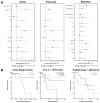Survival of Patients with Gastrointestinal Cancers Can Be Predicted by a Surrogate microRNA Signature for Cancer Stem-like Cells Marked by DCLK1 Kinase
- PMID: 27287716
- PMCID: PMC5082846
- DOI: 10.1158/0008-5472.CAN-16-0029
Survival of Patients with Gastrointestinal Cancers Can Be Predicted by a Surrogate microRNA Signature for Cancer Stem-like Cells Marked by DCLK1 Kinase
Abstract
Doublecortin-like kinase 1 (DCLK1) is a gastrointestinal (GI) tuft cell kinase that has been investigated as a biomarker of cancer stem-like cells in colon and pancreatic cancers. However, its utility as a biomarker may be limited in principle by signal instability and dilution in heterogeneous tumors, where the proliferation of diverse tumor cell lineages obscures the direct measurement of DCLK1 activity. To address this issue, we explored the definition of a miRNA signature as a surrogate biomarker for DCLK1 in cancer stem-like cells. Utilizing RNA/miRNA-sequencing datasets from the Cancer Genome Atlas, we identified a surrogate 15-miRNA expression signature for DCLK1 activity across several GI cancers, including colon, pancreatic, and stomach cancers. Notably, Cox regression and Kaplan-Meier analysis demonstrated that this signature could predict the survival of patients with these cancers. Moreover, we identified patient subgroups that predicted the clinical utility of this DCLK1 surrogate biomarker. Our findings greatly strengthen the clinical significance for DCLK1 expression across GI cancers. Further, they provide an initial guidepost toward the development of improved prognostic biomarkers or companion biomarkers for DCLK1-targeted therapies to eradicate cancer stem-like cells in these malignancies. Cancer Res; 76(14); 4090-9. ©2016 AACR.
©2016 American Association for Cancer Research.
Conflict of interest statement
Courtney Houchen and Edwin Bannerman-Menson are co-founders of COARE Biotechnology Inc.
Figures







Similar articles
-
DCLK1 is a broadly dysregulated target against epithelial-mesenchymal transition, focal adhesion, and stemness in clear cell renal carcinoma.Oncotarget. 2015 Feb 10;6(4):2193-205. doi: 10.18632/oncotarget.3059. Oncotarget. 2015. PMID: 25605241 Free PMC article.
-
DCLK1 in gastrointestinal cancer: A driver of tumor progression and a promising therapeutic target.Int J Cancer. 2025 Jun 1;156(11):2068-2086. doi: 10.1002/ijc.35365. Epub 2025 Mar 8. Int J Cancer. 2025. PMID: 40056091 Review.
-
Evaluation of the cancer stem cell marker DCLK1 in patients with lymph node metastases of head and neck cancer.Pathol Res Pract. 2019 Dec;215(12):152698. doi: 10.1016/j.prp.2019.152698. Epub 2019 Oct 23. Pathol Res Pract. 2019. PMID: 31706685
-
Pancreatic Neuroendocrine Tumors and EMT Behavior Are Driven by the CSC Marker DCLK1.Mol Cancer Res. 2017 Jun;15(6):744-752. doi: 10.1158/1541-7786.MCR-16-0285. Epub 2017 Feb 8. Mol Cancer Res. 2017. PMID: 28179411
-
Functional implication of Dclk1 and Dclk1-expressing cells in cancer.Small GTPases. 2017 Jul 3;8(3):164-171. doi: 10.1080/21541248.2016.1208792. Epub 2016 Jul 26. Small GTPases. 2017. PMID: 27458755 Free PMC article. Review.
Cited by
-
Chemical Biology Toolkit for DCLK1 Reveals Connection to RNA Processing.Cell Chem Biol. 2020 Oct 15;27(10):1229-1240.e4. doi: 10.1016/j.chembiol.2020.07.011. Epub 2020 Aug 4. Cell Chem Biol. 2020. PMID: 32755567 Free PMC article.
-
Long noncoding RNA BMPR1B-AS1 facilitates endometrial cancer cell proliferation and metastasis by sponging miR-7-2-3p to modulate the DCLK1/Akt/NF-κB pathway.Cell Cycle. 2022 Aug;21(15):1599-1618. doi: 10.1080/15384101.2022.2060003. Epub 2022 Apr 11. Cell Cycle. 2022. PMID: 35404759 Free PMC article.
-
Doublecotin-Like Kinase 1 Increases Chemoresistance of Colorectal Cancer Cells through the Anti-Apoptosis Pathway.J Stem Cell Res Ther. 2019;9(3):447. doi: 10.4172/2157-7633.1000447. Epub 2019 May 3. J Stem Cell Res Ther. 2019. PMID: 31372308 Free PMC article.
-
Whole Genome Messenger RNA Profiling Identifies a Novel Signature to Predict Gastric Cancer Survival.Clin Transl Gastroenterol. 2019 Jan;10(1):e00004. doi: 10.14309/ctg.0000000000000004. Clin Transl Gastroenterol. 2019. PMID: 30702489 Free PMC article.
-
DCLK1 Monoclonal Antibody-Based CAR-T Cells as a Novel Treatment Strategy against Human Colorectal Cancers.Cancers (Basel). 2019 Dec 23;12(1):54. doi: 10.3390/cancers12010054. Cancers (Basel). 2019. PMID: 31878090 Free PMC article.
References
-
- Nakanishi Y, Seno H, Fukuoka A, Ueo T, Yamaga Y, Maruno T, et al. Dclk1 distinguishes between tumor and normal stem cells in the intestine. Nature genetics. 2013;45(1):98–9103. - PubMed
MeSH terms
Substances
Grants and funding
LinkOut - more resources
Full Text Sources
Other Literature Sources

